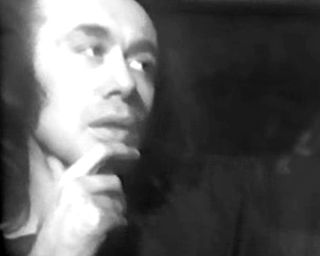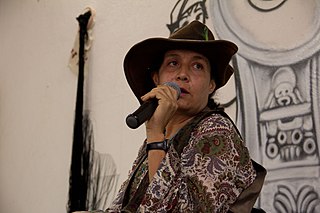Related Research Articles

Performance art is an artwork or art exhibition created through actions executed by the artist or other participants. It may be witnessed live or through documentation, spontaneously developed or written, and is traditionally presented to a public in a fine art context in an interdisciplinary mode. Also known as artistic action, it has been developed through the years as a genre of its own in which art is presented live. It had an important and fundamental role in 20th century avant-garde art.

Vito Acconci was an American performance, video and installation artist, whose diverse practice eventually included sculpture, architectural design, and landscape design. His performance and video art was characterized by "existential unease," exhibitionism, discomfort, transgression and provocation, as well as wit and audacity, and often involved crossing boundaries such as public–private, consensual–nonconsensual, and real world–art world. His work is considered to have influenced artists including Laurie Anderson, Karen Finley, Bruce Nauman, and Tracey Emin, among others.

Carolee Schneemann was an American visual experimental artist, known for her multi-media works on the body, narrative, sexuality and gender. She received a B.A. in poetry and philosophy from Bard College and a Master of Fine Arts from the University of Illinois. Originally a painter in the Abstract Expressionist tradition, Schneeman was uninterested in the masculine heroism of New York painters of the time and turned to performance-based work, primarily characterized by research into visual traditions, taboos, and the body of the individual in relation to social bodies. Although renowned for her work in performance and other media, Schneemann began her career as a painter, saying: "I'm a painter. I'm still a painter and I will die a painter. Everything that I have developed has to do with extending visual principles off the canvas." Her works have been shown at the Los Angeles Museum of Contemporary Art, the Museum of Modern Art in New York, the London National Film Theatre, and many other venues.

Joan Jonas is an American visual artist and a pioneer of video and performance art, and one of the most important artists to emerge in the late 1960s and early 1970s. Jonas' projects and experiments were influential in the creation of video performance art as a medium. Her influences also extended to conceptual art, theatre, performance art and other visual media. She lives and works in New York and Nova Scotia, Canada.

ORLAN is a French multi-media artist who uses sculpture, photography, performance, video, video games, augmented reality, artificial intelligence, and robotics as well as scientific and medical techniques such as surgery and biotechnology to question modern social phenomena. She has said that her art is not body art, but 'carnal art,' which lacks the suffering aspect of body art.

Chicana feminism is a sociopolitical movement, theory, and praxis that scrutinizes the historical, cultural, spiritual, educational, and economic intersections impacting Chicanas and the Chicana/o community in the United States. Chicana feminism empowers women to challenge institutionalized social norms and regards anyone a feminist who fights for the end of women's oppression in the community.

Hannah Wilke (born Arlene Hannah Butter; was an American painter, sculptor, photographer, video artist and performance artist. Wilke's work is known for exploring issues of feminism, sexuality and femininity.
Cheri Gaulke is a visual artist and filmmaker most known for her role in the Feminist Art Movement in southern California in the 1970s and her work on gay and lesbian families.
Faith Wilding is a Paraguayan American multidisciplinary artist - which includes but is not limited to: watercolor, performance art, writing, crocheting, knitting, weaving, and digital art. She is also an author, educator, and activist widely known for her contribution to the progressive development of feminist art. She also fights for ecofeminism, genetics, cyberfeminism, and reproductive rights. Wilding is Professor Emerita of performance art at the School of the Art Institute of Chicago.
Seedbed is a performance piece first performed by Vito Acconci on 15–29 January 1972 at Sonnabend Gallery in New York City.

The feminist art movement in the United States began in the early 1970s and sought to promote the study, creation, understanding and promotion of women's art. First-generation feminist artists include Judy Chicago, Miriam Schapiro, Suzanne Lacy, Judith Bernstein, Sheila de Bretteville, Mary Beth Edelson, Carolee Schneeman, Rachel Rosenthal, and many other women. They were part of the Feminist art movement in the United States in the early 1970s to develop feminist writing and art. The movement spread quickly through museum protests in both New York and Los Angeles, via an early network called W.E.B. that disseminated news of feminist art activities from 1971 to 1973 in a nationally circulated newsletter, and at conferences such as the West Coast Women's Artists Conference held at California Institute of the Arts and the Conference of Women in the Visual Arts, at the Corcoran School of Art in Washington, D.C..
Vanalyne Green is an American artist who also teaches and writes about culture. She has screened her video work extensively in the United States and abroad, including The Whitney Biennial (1991), American Film Institute, Rotterdam International Film Festival, the Videotheque de Paris, The Robert Flaherty Film Seminar, The Guggenheim Museum and many other museums, universities and film festivals. She has received a Guggenheim Foundation fellowship, as well as grants from Creative Capital, the Jerome Foundation, the Richard H. Driehaus Foundation (2003), the National Endowment for the Arts, the New York State Council of the Arts, and a Rome Prize at the American Academy in Rome (2001–2002). Her work has been covered in the Village Voice, the Los Angeles Weekly, The Chicago Reader, and Artforum. Publications by and about, and interviews with, Green also can be found in "Performance Artists Talking in the Eighties" by Linda M. Montano, "Women of Vision" by Alexandra Juhasz, in addition to M/E/A/N/I/N/G: An Anthology of Artists' Writings, Theory, and Criticism. Green's videotape "A Spy in the House that Ruth Built" was listed as one of the 1,000 best films ever made by film critic and author Jonathan Rosenbaum.

Lynda Benglis is an American sculptor and visual artist known especially for her wax paintings and poured latex sculptures. She maintains residences in New York City, Santa Fe, New Mexico, Kastellorizo, Greece, and Ahmedabad, India.
Barbara Turner Smith is an American artist known for her performance art in the late 1960s, exploring themes of food, nurturing, the body, spirituality, and sexuality. Smith was part of the Feminist Movement in Southern California in the 1970s and has collaborated in her work with scientists and other artists. Her work has been widely exhibited and collected by major museums including the J. Paul Getty Museum, the Hammer Museum, MOCA, LACMA, and the Art Institute of Chicago.
Patty Chang is an American performance artist and film director living and working in Los Angeles, California. Originally trained as a painter, Chang received her Bachelor of Arts at the University of California, San Diego. It wasn't until she moved to New York that she became involved with the performance art scene.

Mira Schor is an American artist, writer, editor, and educator, known for her contributions to critical discourse on the status of painting in contemporary art and culture as well as to feminist art history and criticism.
Martha Wilson is an American feminist performance artist and the founding director of Franklin Furnace Archive art organization. Over the past four decades she has developed and "created innovative photographic and video works that explore her female subjectivity through role-playing, costume transformation, and 'invasions' of other peoples personas". She is a recipient of two National Endowment for the Arts fellowships, a New York Foundation for the Arts fellowship, and an Obie Award and a Bessie Award for commitment to artists’ freedom of expression. She is represented by P•P•O•W gallery in New York City.
The feminist art movement refers to the efforts and accomplishments of feminists internationally to produce art that reflects women's lives and experiences, as well as to change the foundation for the production and perception of contemporary art. It also seeks to bring more visibility to women within art history and art practice. The movement challenges the traditional hierarchy of arts over crafts, which views hard sculpture and painting as superior to the narrowly perceived 'women's work' of arts and crafts such as weaving, sewing, quilting and ceramics. Women artists have overturned the traditional view by, for example, using unconventional materials in soft sculptures, new techniques such as stuffing, hanging and draping, and for new purposes such as telling stories of their own life experiences. The objectives of the feminist art movement are thus to deconstruct the traditional hierarchies, represent women more fairly and to give more meaning to art. It helps construct a role for those who wish to challenge the mainstream narrative of the art world. Corresponding with general developments within feminism, and often including such self-organizing tactics as the consciousness-raising group, the movement began in the 1960s and flourished throughout the 1970s as an outgrowth of the so-called second wave of feminism. It has been called "the most influential international movement of any during the postwar period."

Ximena Cuevas is a Mexican video performance artist. Her works often explore the social and gender issues facing lesbians in Mexico. Cuevas's videos and films have screened at Sundance, New York's Museum of Modern Art, the Guggenheim Museum,
Honey Lee Cottrell was a lesbian photographer and filmmaker who lived most of her life in San Francisco, California. Her papers are part of the Human Sexuality Collection at Cornell University Library.
References
- ↑ "s u s a n m o g u l". s u s a n m o g u l. Retrieved 2014-07-07.
- ↑ "James M. Moran - Susan Mogul: At Home in Los Angeles - Wide Angle 20:3". Pitzer.edu. 1998-02-27. Retrieved 2014-07-07.
- ↑ "Susan Mogul - John Simon Guggenheim Memorial Foundation". Gf.org. Retrieved 2014-07-07.
- ↑ "Take Off | Video Data Bank". Vdb.org. Retrieved 2014-07-07.
- ↑ "s u s a n m o g u l". s u s a n m o g u l. Retrieved 2014-07-07.
- ↑ "Susan Mogul | Video Data Bank". Vdb.org. Retrieved 2014-07-07.
- ↑ "s u s a n m o g u l". s u s a n m o g u l. 2008-08-15. Retrieved 2014-07-07.
- ↑ "Susan Mogul - John Simon Guggenheim Memorial Foundation". Gf.org. Retrieved 2014-07-07.
- ↑ "s u s a n m o g u l". s u s a n m o g u l. Retrieved 2014-07-07.
- ↑ "Susan Mogul - John Simon Guggenheim Memorial Foundation". Gf.org. Retrieved 2014-07-07.
- ↑ "Susan Mogul - John Simon Guggenheim Memorial Foundation". Gf.org. Retrieved 2014-07-07.
- ↑ "s u s a n m o g u l". s u s a n m o g u l. Retrieved 2014-07-07.